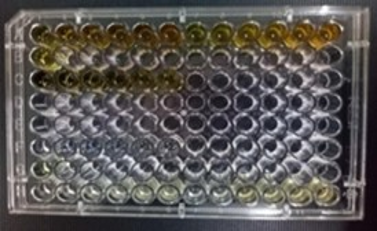Abstract
Diabetes has become a global health concern, its management lies hugely on expensive medical care and monitoring; thus the need to investigate possible alternatives to reduce treatment cost and also to reduce the side effects of commonly used anti diabetic drugs. This study aims to assess the antidiabetic effect of mixed fruit juice nanoemulsion of Coccinia grandis, Punica granatum and Phyllanthus emblica. Mixed fruit juice nanoemulsion were prepared in the ratio of VCO oil:water:surfactant- 32:36:32 (%w/w). characterization parameters of mixed fruit juice nanoemulsion including PH , zeta poten- tial, size, morphology were within the standard limits and was used for the study. The anti diabetic effect of nano emulsified mixed fruit juice was compared with that of acarbose by measuring their inhibitory effect on the enzyme alpha glucosidase. Maximum Inhibitory effect of formulated Nano emulsion on enzyme alpha glucosidase was 83% at concentration 81µg/ml whereas that for the standard anti-diabetic drug Acarbose was 93% at concentration 540µg/ml. For acarbose, the maximum Inhibition was 92% at the concentration of 540µg/ml. The relative inhibition Percentage of Nano emulsion versus Control has been analyzed and the results found to be statistically significant (P<0.003).
Full text article
References
Dwivedi, C., Daspaul, S. 2013. Antidiabetic Herbal Drugs and Polyherbal Formulation Used For Diabetes: A Review. The Journal of Phytopharmacology , 2(23):44–51.
Fatima, M., Sadeeqa, S., Nazir, S. U. R. 2018. Metformin and its gastrointestinal problems: A review. Biomedical Research, 29(11):2285–2289.
George, J. A., Erasmus, R. T. 2018. Haemoglobin A1c or Glycated Albumin for Diagnosis and Monitoring Diabetes: An African Perspective. Indian Journal of Clinical Biochemistry, 33(3):255–261.
Gunasekaran, T., Haile, T., Nigusse, T., Dhanaraju, M. D. 2014. Nanotechnology: an effective tool for enhancing bioavailability and bioactivity of phytomedicine. Asian Pacific Journal of Tropical Biomedicine, 4(1):S1–S7.
Li, S., Wang, J., Zhang, B., Li, X., Liu, Y. 2019. Diabetes Mellitus and Cause-Specific Mortality: A Population-Based Study. Diabetes Metab J, 43(3):319–341.
Marín-Peñalver, J. J., Martín-Timón, I., Sevillano- Collantes, C., del Cañizo-Gómez, F. J. 2016. Update on the treatment of type 2 diabetes mellitus. World Journal of Diabetes, 7(17):354–354.
Nayak, A., De, S. 2013. Anti Diabetic Potential Medic- inal Plants. BioMedRx, 1(1):32–46. Orasanu, G., Plutzky, J. 2010. The Continuum of Diabetic Vascular Disease: From Macro- to Micro. Group, 29(4):249–271.
Patel, D. K., Prasad, S. K., Kumar, R., Hemalatha, S. 2012. An overview on antidiabetic medicinal plants having insulin mimetic property. Asian Pacific Journal of Tropical Biomedicine, 2(4):320– 330.
Rojas, L. B. A., Gomes, M. B. 2013. Metformin: An old but still the best treatment for type 2 diabetes. Diabetology and Metabolic Syndrome, 5(1):1–15.
Salehi, Ata, Kumar, V. A., Sharopov, Ramírez- Alarcón, Ruiz-Ortega, Ayatollahi, A., Fokou, T., Kobarfard, Zakaria, A., Iriti, Taheri, Martorell, Sureda, Setzer, Durazzo, Lucarini, Santini, Capasso, Ostrander, ur Rahman, A., Choudhary, Cho, Sharifi-Rad 2019. Antidiabetic Potential of Medicinal Plants and Their Active Components. Biomolecules, 9(10):551–551.
Saxena, V., Hasan, A., Sharma, S., Pandey, L. M. 2018. Edible oil nanoemulsion: An organic nanoantibiotic as a potential biomolecule delivery vehicle. International Journal of Polymeric Materials and Polymeric Biomaterials, 67(7):410–419.
Shrivastava, S. R., Shrivastava, P. S., Ramasamy, J. 2013. Role of self-care in management of diabetes mellitus. Journal of Diabetes & Metabolic Disorders, 12(1).
Sola, D., Rossi, L., Schianca, G. P. C., Maffioli, P., Bigliocca, M., Mella, R., Corlianò, F., Fra, G. P., Bartoli, E., Derosa, G. 2015. State of the art paper Sulfonylureas and their use in clinical practice. Archives of Medical Science, 4(4):840–848.
Thakur, L. 2011. Novel approaches for stability improvement in natural medicines. Pharmacognosy Reviews, 5(9):48–54.
Authors

This work is licensed under a Creative Commons Attribution-NonCommercial-NoDerivatives 4.0 International License.

